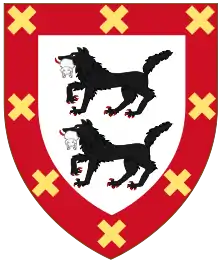Fernando Díaz de Haro (Lord of Orduña and Balmaseda)
Fernando Díaz de Haro was a Spanish noble of the House of Haro. He was the second born son of Diego López V de Haro, the Lord of Biscay, and his wife, the infanta Violante de Castilla y Aragón, daughter of Alfonso X of Castile. Fernando became lord of Orduña and Balmaseda in 1322, after the death of his brother, Lope Díaz IV de Haro who died without leaving any descendants.

Family Origins
Fernando Diaz was the son of Diego López V de Haro, who rose to power after forcibly taking the title over Lordship of Biscay. His mother was Violante de Castilla y Aragón. His paternal grandparents were Diego Lopez III de Haro, and his wife, Constanza de Bearn. His maternal grandparents were King Alfonso X of Castile and his wife, Violant of Aragon, daughter of King James I of Aragon.
Biography
The exact date of Fernando's birth is unknown but it is known that he married in 1315[1] with Maria of Portugal, Lady of Meneses and Orduña, daughter of the infante Alfonso de Portugal and his wife, Violante Manuel, sister of Juan Manuel, Prince of Villena.
At the death of his brother in 1322, Fernando Diaz inherited title over Orduña and Balmaseda. It appears that he passed these titles on to his son, but that they eventually wound up in the hands of the monarchy, and this once powerful ancient bloodline of the House of Haro falls from prominence.
His date of death is unknown.
Marriage and Descendants
Fernando Diaz married Maria of Portugal, Lady of Meneses and Orduña in 1315. She was the widow of Tello Alfonso de Meneses and daughter of Alfonso de Portugal, granddaughter of Alfonso III of Portugal and his wife, Violante Manuel, tracing her descendancy back to Ferdinand III of Castile the saint. This marriage bore two sons:
- Diego López VI de Haro, who inherited his father's titles over Orduña and Balmaseda, possibly the last Haro to hold them. Married Juana de Castro II, the daughter of Pedro Fernández de Castro, lord of Sarria and Condado de Lemos, and his wife, Isabel Ponce de León.
- Pedro López de Haro, who died early.
See also
References
- Cawley, Charles, VIZCAYA: Fernando Diaz M 1315, Medieval Lands database, Foundation for Medieval Genealogy,
Bibliography
- Benavides, Antonio (1860). Memorias de Don Fernando IV de Castilla (1ª ed.). Madrid: Imprenta de Don José Rodríguez.
- Colmeiro y Penido, Manuel; Manuel Colmeiro y Penido (1883). Cortes de los antiguos Reinos de León y de Castilla. Madrid: Establecimiento tipográfico de los sucesores de Rivadeneyra, impresores de la Real Casa.
- González-Doria, Fernando (2000). Diccionario heráldico y nobiliario de los Reinos de España (1ª ed.). San Fernando de Henares (Madrid): Ediciones Trigo S. L. ISBN 84-89787-17-4.
- De Loaysa, Jofré; García Martínez, Antonio (1982). Academia Alfonso X el Sabio, Colección Biblioteca Murciana de bolsillo Nº 27 (ed.). Crónicas de los Reyes de Castilla Fernando III, Alfonso X, Sancho IV y Fernando IV (1248-1305) (2ª ed.). Murcia. ISBN 84-00-05017-7.
- Mariana, Juan de; Juan de Mariana (1855). Imprenta y librería de Gaspar y Roig, editores (ed.). Historia General de España (Reedición ed.). Madrid: Gaspar y Roig.
JUAN DE MARIANA.
- Menéndez Pidal de Navascués, Faustino; Faustino Menéndez Pidal de Navascués (1982). Instituto Luis de Salazar y Castro (ed.). Heráldica medieval española. Volumen I: La Casa Real de Castilla y León. Hidalguía. ISBN 8400051505.
- Menezo Otero, Juan José (2005). Reinos y Jefes de Estado desde el 712 (5ª ed.). Madrid: Historia Hispana. ISBN 84-604-9610-4.
- Novia de Salcedo, Pedro; Pedro Novia de Salcedo (1851). Librería de Delmas e Hijo (ed.). Defensa histórica, legislativa y económica del señorío de Vizcaya y provincias de Alava y Guipúzcoa. Bilbao.
- Núñez de Villaizán, Juan; Francisco Cerdá y Rico (1787). Francisco Cerdá y Rico (ed.). Crónica de D. Alfonso el Onceno de este nombre. Madrid: Imprenta de D. Antonio de Sancha.
- Núñez de Villaizán, Juan; Catalán, Diego (1977). Seminario Menéndez Pidal, Universidad Complutense de Madrid (ed.). Gran crónica de Alfonso XI (1ª ed.). Madrid: Editorial Gredos. ISBN 8460007979.
- Rodríguez García, Francisco (2002). Crónica del Señorío de Vizcaya (1ª ed.). Editorial Maxtor Librería. ISBN 84-9761-029-6.
- Del Valle Curieses, Rafael (2000). María de Molina: el soberano ejercicio de la concordia: (1260-1321). Madrid : Alderabán. ISBN 84-95414-03-1.